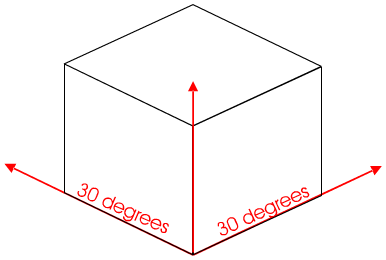
isometric [ahy-suh-me-trik] ExamplesWord Origin adjective Also i·so·met·ri·cal.
- of, relating to, or having equality of measure.
- of or relating to isometric exercise.
- Crystallography. noting or pertaining to that system of crystallization that is characterized by three equal axes at right angles to one another.Compare crystal system.
- Prosody. of equal measure; made up of regular feet.
- Drafting. designating a method of projection (isometric projection) in which a three-dimensional object is represented by a drawing (i·somet·ric draw·ing) having the horizontal edges of the object drawn usually at a 30° angle and all verticals projected perpendicularly from a horizontal base, all lines being drawn to scale.Compare orthographic projection.
noun
- isometrics, isometric exercise(def 1).
- an isometric drawing.
- Also called isometric line. Physics. isochore(def 1).
Origin of isometric 1830–40; Greek isometr(ía) isometry + -ic Related formsi·so·met·ri·cal·ly, adverbpseu·do·i·so·met·ric, adjectiveun·i·so·met·ri·cal, adjective Examples from the Web for isometric Contemporary Examples of isometric
In an isometric squat, drop down into your squat position and then just hold it there for as long as you can.
Squats: The Absolutely Incredible Secret to Staying in Shape
Ari Meisel
January 2, 2014
Historical Examples of isometric
Isometric crystals, usually cubes with edges modified, are common.
William J. Miller
Crystals of usually octahedral habit in the isometric system.
William J. Miller
A chart—size 14×28 inches—showing in isometric perspective the mechanisms belonging in a modern boiler room.
Victor Wilfred Pag
A new specially ruled paper to enable you to make sketches or drawings in isometric perspective without any figuring or fussing.
Victor Wilfred Pag
Isometric projection enables one to show the length, breadth, and thickness of an object drawn to scale on the one drawing.
Various
British Dictionary definitions for isometric isometric adjective Also: isometrical
- having equal dimensions or measurements
- physiol of or relating to muscular contraction that does not produce shortening of the muscle
- (of a crystal or system of crystallization) having three mutually perpendicular equal axes
- crystallog another word for cubic (def. 4)
- prosody having or made up of regular feet
- (of a method of projecting a drawing in three dimensions) having the three axes equally inclined and all lines drawn to scale
noun
- Also called: isometric drawing a drawing made in this way
- Also called: isometric line a line on a graph showing variations of pressure with temperature at constant volume
Derived Formsisometrically, adverbWord Origin for isometric C19: from Greek isometria (see iso- + -metry) + -ic Word Origin and History for isometric adj.
1838, literally “of the same measure,” coined from Greek isos “equal” (see iso-) + metron “measure” (see meter (n.2)). Originally a method of using perspective in drawing; the physiological sense relating to muscular action is from 1891, from German isometrisch in this sense (1882).
isometric in Medicine isometric [ī′sə-mĕt′rĭk] adj.
- Of or exhibiting equality in dimensions or measurements.
- Of, relating to, or being a crystal system of three equal axes lying at right angles to each other.
- Of or involving muscular contraction against resistance in which the length of the muscle remains the same.
isometric in Science isometric [ī′sə-mĕt′rĭk] Adjective
- See cubic.
- Of or involving muscular contraction against resistance in which the length of the muscle remains the same.
- A graph showing the relationship between two quantities, such as pressure and temperature, when a third quantity, such as volume, is held constant.
 Liberal Dictionary English Dictionary
Liberal Dictionary English Dictionary